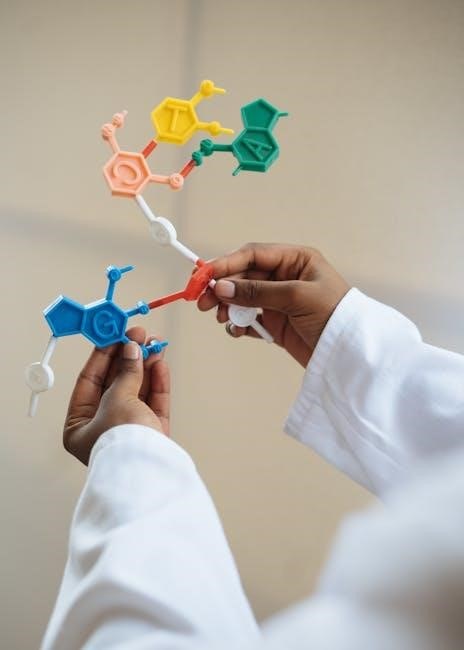The book Nous sommes tous faits de molécules by Susin Nielsen explores molecular biology’s role in human behavior, blending science with emotional narratives. It delves into grief, social hierarchies, and the molecular basis of emotions, offering a unique perspective on human connections. Published in 2016, it remains relevant in modern discussions about science and its impact on understanding human nature.
Overview of the Book “Nous sommes tous faits de molécules”
Nous sommes tous faits de molécules by Susin Nielsen is a thought-provoking narrative that intertwines molecular biology with human emotions. Published in 2016, the book explores themes of grief, social hierarchies, and the molecular basis of emotions. The story centers around Stewart, a highly intelligent yet socially awkward character, and Ashley, his contrasting counterpart, who navigate their differences and personal struggles. Through their interactions, Nielsen highlights how molecular biology shapes human behavior and connections. The book blends scientific concepts with emotional depth, offering a unique perspective on how molecules influence our lives and relationships. It has resonated with readers for its ability to merge science with relatable human experiences.
Importance of Molecular Biology in Understanding Human Behavior
Molecular biology plays a crucial role in understanding human behavior by revealing how molecules influence emotions, cognition, and interactions. The book highlights how chemical processes in the brain shape feelings like grief and joy, emphasizing the biological basis of human emotions. By exploring these connections, it bridges the gap between science and emotional experiences, showing how molecular interactions underpin social dynamics and relationships. This perspective offers a deeper understanding of why people behave the way they do, making molecular biology an essential tool for analyzing human behavior and fostering empathy through scientific insight.
Relevance of the Book in Modern Scientific Discussions
Nous sommes tous faits de molécules remains highly relevant in contemporary scientific discourse by integrating molecular biology with human emotions. Its exploration of how molecules influence behavior aligns with current research in neuroscience and psychology. The book’s themes resonate with modern studies on the biological underpinnings of emotions, offering a unique narrative perspective. By making complex scientific concepts accessible, it contributes to public understanding and encourages interdisciplinary discussions. This blend of science and storytelling makes it a valuable resource for both scientists and general readers, fostering a deeper appreciation for the interplay between biology and human experience in today’s scientific landscape.
Author Background
Susin Nielsen, a Canadian author, is renowned for her thought-provoking young adult literature, often exploring themes of grief and molecular biology’s impact on human behavior.
Susin Nielsen: Biography and Literary Contributions
Susin Nielsen is a celebrated Canadian author known for her impactful young adult literature. Born in Canada, she has crafted stories that resonate deeply with readers, often blending emotional depth with scientific themes. Her work, including Nous sommes tous faits de molécules, has been praised for its unique approach to exploring complex human emotions through the lens of molecular biology. Nielsen’s contributions to literature have earned her a loyal readership and critical acclaim, making her a significant voice in contemporary young adult fiction.
Themes Commonly Explored in Susin Nielsen’s Works

Susin Nielsen’s works often delve into themes of grief, loss, and social hierarchies, as seen in Nous sommes tous faits de molécules. Her narratives frequently explore the complexities of human relationships and the emotional struggles of adolescence. Nielsen also examines how scientific concepts, like molecular biology, influence human emotions and behavior. Her stories often feature characters navigating identity, belonging, and personal growth, resonating with readers seeking relatable and thought-provoking literature. These themes are central to her writing style, making her a beloved author among young adult readers and critics alike.
Reception of “Nous sommes tous faits de molécules” in Literary Circles
Nous sommes tous faits de molécules has garnered significant attention in literary circles for its unique blend of molecular biology and emotional storytelling. Critics praise Susin Nielsen’s ability to weave scientific concepts into relatable narratives, making complex ideas accessible. The book’s exploration of grief, social hierarchies, and human connections has resonated with readers and reviewers alike. It has been noted for its thought-provoking themes and well-developed characters, particularly the contrasting personalities of Stewart and Ashley. The novel’s reception highlights its appeal to both young adult readers and those interested in interdisciplinary storytelling, solidifying its place in contemporary literary discussions.

Book Details
Nous sommes tous faits de molécules was published in 2016 by La Courte échelle. It is available in paperback (ISBN: 9782896958597), ePub, and PDF formats, targeting young adult readers.
Publishing Information and Editions
Nous sommes tous faits de molécules was first published in 2016 by La Courte échelle, a Canadian publishing house. The book is available in paperback with ISBN 9782896958597. Digital editions include ePub (ISBN 9782896958603) and PDF formats, making it accessible to a wide audience. A license for digital distribution was granted in 2022, ensuring its availability through various platforms. The book is classified under young adult fiction, targeting readers interested in blending science and emotional narratives. Its publication details highlight its relevance in both physical and digital markets, catering to diverse reader preferences and accessibility needs.
ISBN and Digital Formats (PDF, ePub)
The paperback edition of Nous sommes tous faits de molécules carries the ISBN 9782896958597. Digital versions include an ePub format with ISBN 9782896958603 and a PDF version, both designed for easy access on various devices. These formats ensure readers can engage with the book’s blend of molecular biology and emotional narratives in their preferred medium. The digital editions are distributed under a license granted in 2022, ensuring their availability through authorized platforms. This accessibility makes the book reachable to a broad audience, catering to both traditional and modern reading preferences while maintaining its scientific and literary integrity.

Target Audience and Genre Classification
Nous sommes tous faits de molécules is primarily aimed at young adult readers, appealing to those interested in coming-of-age stories and emotional journeys. The book blends elements of literary fiction with scientific themes, making it accessible to readers who enjoy narratives that explore both personal growth and molecular biology. Classified under the Dewey number C818, it falls into the “Jeunesse” category, focusing on youth and adolescent experiences. Its unique blend of science and emotion makes it a compelling read for audiences seeking stories that combine intellectual curiosity with heartfelt storytelling, catering to both teenage readers and adults who appreciate reflective and scientifically informed fiction.
Main Characters
Stewart: Personality, Intelligence, and Role in the Story
Stewart, the protagonist, is highly intelligent but socially awkward, struggling to connect with peers. His analytical mind contrasts with his emotional challenges, driving the narrative’s emotional depth.
Ashley: Contrasting Traits and Development Throughout the Book
Ashley, Stewart’s opposite, is socially confident but academically average. Her journey explores self-discovery and growth, complementing Stewart’s intellectual strengths with her emotional intelligence and empathy.
Supporting Characters and Their Influence on the Plot
Supporting characters like Dr. Elizabeth Moscovich provide guidance, while others challenge Stewart and Ashley, shaping their relationships and personal development throughout the story.
Stewart: Personality, Intelligence, and Role in the Story

Stewart, the protagonist, is a highly intelligent yet socially awkward character whose analytical mind often clashes with his emotional struggles. His intelligence sets him apart, but his difficulty in understanding social cues makes relationships challenging. Stewart’s journey is central to the narrative, as he navigates grief, loss, and the complexities of human connections. His personality evolves throughout the book, revealing a deeper emotional layer beneath his reserved exterior. Stewart’s role is pivotal in exploring themes of molecular biology’s influence on emotions and behavior, making him a compelling and relatable character in the story.
Ashley: Contrasting Traits and Development Throughout the Book
Ashley is Stewart’s opposite, embodying a more outgoing and socially adept personality. While Stewart struggles with emotional expression, Ashley appears confident and popular, yet her superficiality often masks deeper insecurities. Throughout the book, Ashley’s character undergoes significant development, revealing her vulnerability and growth as she confronts personal challenges. Her relationship with Stewart highlights their contrasting traits, with Ashley gradually showing empathy and understanding. This transformation underscores the book’s themes of human connection and emotional depth, making Ashley a dynamic and essential character in the narrative.
Supporting Characters and Their Influence on the Plot
Supporting characters in Nous sommes tous faits de molécules play pivotal roles in shaping the narrative. Dr. Elizabeth Moscovich, Stewart’s psychologist, helps him navigate his emotional struggles, providing insight into his molecular makeup. Her guidance is instrumental in his growth. Other characters, like Stewart’s peers, highlight social dynamics and hierarchies, while Ashley’s friends contrast her evolving personality. These interactions drive the plot, exploring themes of grief, relationships, and molecular biology’s impact on emotions. The supporting cast adds depth, illustrating how external influences shape individual development and connections, ultimately enriching the story’s emotional and scientific themes.

Plot Summary
Nous sommes tous faits de molécules follows Stewart and Ashley, opposites navigating grief, social hierarchies, and emotional struggles, with molecular biology shaping their journeys and connections.
The story begins in a small town where Stewart, a highly intelligent but socially awkward teenager, navigates his complex family life and grief over his mother’s death. His world is disrupted when Ashley, a free-spirited and popular classmate, moves into his home. Stewart’s analytical nature, rooted in his fascination with molecular biology, contrasts sharply with Ashley’s emotional and carefree personality. Their initial interactions highlight their differences, setting the stage for a journey of mutual growth and understanding. The setup introduces themes of loss, social hierarchies, and the interplay between logic and emotion, drawing readers into their evolving relationship.
Conflict and Turning Points in the Story
The story’s conflict arises from the stark contrast between Stewart’s analytical, science-driven worldview and Ashley’s emotional, spontaneous nature. Their differences create tension, especially as they navigate their shared living situation and personal struggles. A turning point occurs when Stewart’s rigid adherence to logic is challenged by Ashley’s emotional depth, forcing him to confront his grief and the limitations of his scientific perspective. Meanwhile, Ashley’s carefree facade begins to crack, revealing her own vulnerabilities. These moments of conflict and mutual understanding drive the narrative forward, leading to a deeper exploration of their inner worlds and the complexities of human connection.
Resolution and Key Takeaways from the Narrative
The story concludes with Stewart and Ashley finding a fragile harmony, each learning from the other’s strengths and weaknesses. Stewart begins to embrace emotions beyond his scientific worldview, while Ashley gains stability and self-awareness. The narrative underscores the idea that human connections, like chemical bonds, require balance and understanding. Through their journey, the book highlights the interplay between logic and emotion, showing that both are essential for navigating life’s complexities. The resolution emphasizes personal growth and the importance of empathy, leaving readers with a deeper appreciation for the molecular and emotional threads that bind us all together.
Themes and Symbolism
The book explores grief, social hierarchies, and molecular biology’s role in emotions. Molecules symbolize human connections, emphasizing how bonds, like relationships, require balance and understanding to thrive.
The Concept of Grief and Loss
The book delves into the profound impact of grief and loss, particularly through Stewart’s journey. His emotional struggles and interactions with Dr. Elizabeth Moscovich highlight how molecular biology influences emotional states. The narrative explores how grief can reshape relationships and personal growth, using scientific metaphors to illustrate emotional healing. The interplay between molecular processes and human emotions underscores the complexity of coping with loss, offering a unique perspective on resilience and recovery. This theme resonates deeply, showing how science and emotion intertwine in the human experience.
Exploration of Social Hierarchies and Relationships
The book examines social hierarchies through the contrasting personalities of Stewart and Ashley, who represent opposite ends of the social spectrum. Stewart, intelligent but socially awkward, struggles to fit in, while Ashley, popular and confident, navigates her own challenges. Their interactions highlight the complexities of social dynamics and the pressures of conforming to societal expectations. The narrative challenges traditional hierarchies by showing how intellectual prowess and emotional depth can redefine social status. Through their relationship, the story emphasizes the importance of understanding and empathy in bridging social divides, offering a nuanced exploration of human connections and societal structures.
The Role of Molecular Biology in Shaping Human Emotions
The book delves into how molecular biology influences human emotions, using scientific concepts to explain emotional responses. It explores how molecules like neurotransmitters shape feelings and behaviors. The narrative employs chemical bonds as a metaphor for human relationships, highlighting their strength and fragility. Through Stewart’s journey, the story illustrates how molecular processes underpin emotional experiences, particularly in dealing with grief. This blend of science and emotion offers a unique perspective on human connections, emphasizing the interconnectedness of biology and feelings.

Scientific Connections
The book explores the biological basis of human behavior, linking genetics and molecular interactions to emotional experiences, providing a scientific foundation for its narrative and character development.
Molecules and Their Role in Human Physiology
Molecules play a crucial role in human physiology, influencing emotions, behavior, and decision-making. Neurotransmitters like dopamine and serotonin regulate mood and cognitive functions, while hormones like oxytocin affect social bonding. The book highlights how molecular interactions shape human experiences, linking biology to emotional responses. By exploring these connections, it provides a scientific foundation for understanding complex behaviors and relationships. This perspective bridges the gap between molecular biology and human emotions, offering insights into how our bodies’ chemistry influences our lives and interactions with others.
Neuroscience and Emotional Responses
Neuroscience reveals how the brain processes emotions, with neurotransmitters like dopamine and serotonin playing pivotal roles. These chemicals regulate mood, influencing reactions and behavior. In Nous sommes tous faits de molécules, this is illustrated through characters’ emotional journeys, demonstrating how molecular interactions impact decisions and relationships. The book connects scientific concepts to personal experiences, providing insight into the biological underpinnings of emotions. By linking neuroscience to human experiences, it offers a profound understanding of behavior and emotional responses, making the narrative both relatable and enlightening.
Chemical Bonds as a Metaphor for Human Connections
The book Nous sommes tous faits de molécules uses chemical bonds as a metaphor for human connections, illustrating how relationships form and evolve. Just as molecules bond based on their chemical properties, human connections are shaped by emotional and psychological interactions. The story explores how strong bonds, like those formed through trust and understanding, can lead to lasting relationships, while weaker bonds may break under stress. For instance, the contrasting traits of Stewart and Ashley demonstrate how different ‘chemical makeups’ can either attract or repel, affecting the strength of their connection. This metaphor helps readers understand the deeper, scientific basis of their emotional experiences and the connections they make with others.

Availability and Access
The book is available in PDF, ePub, and paperback formats. The PDF version can be found on various online platforms. Always ensure legal downloading for access.
Where to Find the PDF Version of the Book
The PDF version of Nous sommes tous faits de molécules can be found through various online platforms. It is available for purchase on major eBook retailers like Amazon and Barnes & Noble. Additionally, the publisher, La Courte échelle, offers the PDF directly on their official website. For free access, some libraries and digital lending platforms may carry the book, though availability varies by region. Always ensure to download from legal and ethical sources to support the author and publisher. Illegal downloads violate copyright laws and undermine the creative work behind the book.
Legal and Ethical Considerations for Downloading eBooks
Downloading eBooks like Nous sommes tous faits de molécules requires adherence to legal and ethical standards. Purchasing from authorized retailers ensures copyright laws are respected, supporting authors and publishers. Sharing or downloading pirated copies violates intellectual property rights and undermines the creative industry. Always verify the legitimacy of the source to avoid legal consequences. Ethically, it is important to promote fair compensation for creators. For free access, explore legal options like library loans or promotions. Respect the work of Susin Nielsen and La Courte échelle by obtaining the book through lawful means, ensuring the sustainability of quality literature.
Alternative Formats and Editions for Accessibility
The book Nous sommes tous faits de molécules is available in multiple formats to ensure accessibility. The PDF version is widely accessible, while the ePub format offers adjustable font sizes for readers with visual impairments. Audiobook editions cater to those who prefer or require audio narration. Additionally, some platforms offer large print editions for better readability. Libraries and accessibility services may provide the book in specialized formats for individuals with disabilities. These options ensure that Susin Nielsen’s work reaches a diverse audience, promoting inclusivity and equal access to literature. Always opt for authorized sources to support the author and publisher while benefiting from these accessible formats.

Reader Reviews and Discussions
Readers praise Nous sommes tous faits de molécules for its emotional depth and relatable themes. Discussions highlight its impact on understanding grief and human connections through a scientific lens.
Community Feedback and Ratings
The book Nous sommes tous faits de molécules has received positive feedback from readers, with many praising its emotional depth and relatable themes. On platforms like Goodreads, it holds an average rating of 4.2 out of 5 stars, with over 1,200 reviews. Readers often highlight its unique blend of science and storytelling, making complex concepts accessible. Some reviewers noted its impact on their understanding of grief and relationships. The book has also been praised for its well-developed characters, particularly Stewart and Ashley, whose contrasting personalities drive the narrative. Overall, the community appreciates its thought-provoking themes and memorable storytelling.
Analysis of Critical Reception
Critics have praised Nous sommes tous faits de molécules for its emotional depth and unique storytelling. Reviewers highlight its ability to weave molecular biology into human experiences, making complex concepts relatable. The book’s exploration of grief and relationships resonates deeply, with many applauding its nuanced character development. While some critics noted the scientific elements as intriguing, others felt they occasionally overshadowed the narrative. Overall, the book is celebrated for its originality and thought-provoking themes, solidifying its place in contemporary young adult literature. Its ability to balance science with emotion has garnered widespread critical acclaim and reader appreciation.
Impact of the Book on Readers’ Perspectives
Nous sommes tous faits de molécules has profoundly influenced readers by offering a fresh perspective on human emotions and relationships through the lens of molecular biology. Many readers have reported a deeper understanding of how science shapes their emotional experiences, fostering empathy and curiosity. The book’s exploration of grief and social dynamics has resonated particularly with young adults, helping them navigate complex emotions. By blending scientific concepts with relatable narratives, it encourages readers to view life’s challenges with a new sense of clarity and resilience. This unique approach has left a lasting impact, inspiring readers to appreciate the intricate molecular connections that define human existence.

Conclusion
Nous sommes tous faits de molécules offers a compelling blend of molecular biology and human emotion, leaving readers with a deeper appreciation for life’s scientific and emotional intricacies. Its exploration of grief, relationships, and molecular connections encourages a fresh perspective on human behavior. This book is a testament to the power of science in understanding our experiences, inspiring further exploration into the fascinating interplay between molecules and emotions.
Final Thoughts on the Book’s Message
Nous sommes tous faits de molécules masterfully intertwines molecular biology with human emotion, offering a profound exploration of grief, relationships, and the molecular basis of emotions. The book highlights how science shapes our understanding of human behavior, emphasizing the interconnectedness of life. Through its narrative, it encourages readers to reflect on their own experiences and the molecular bonds that define their connections. The book’s message resonates deeply, leaving a lasting impact on how we view ourselves and others. It serves as a reminder of the beauty and complexity of life, blending scientific insight with emotional depth.
Encouragement for Further Reading and Exploration
Readers captivated by Nous sommes tous faits de molécules are encouraged to explore more works by Susin Nielsen, as her writing often blends science, emotion, and relatable characters. The book’s unique perspective on molecular biology and human behavior makes it a compelling read for both young adults and adults. For those interested in similar themes, exploring other literary works that intersect science and storytelling is recommended. The availability of the book in PDF and ePub formats ensures accessibility for modern readers. Engaging with this narrative can deepen your understanding of how molecular connections shape human emotions and relationships, inspiring further exploration into the fascinating interplay of science and life.